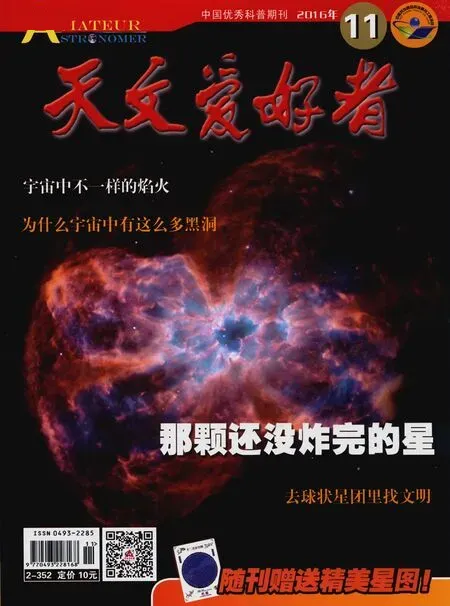双语小知识(五)
□ 曹 燕
双语小知识(五)
□ 曹 燕
Exoplanets 系外行星(一)
It feels like every time astronomers even look at a star these days, they find a planet or two in orbit around it. They’ve confirmed about 3500 planets in all, with thousands more awaiting confirmation. The planets range from about the mass of the Moon to many times the mass of Jupiter, the largest planet in the solar system. Some are quite close to their parent stars, while others are far away. And some orbit a single star, while others have two suns in their sky — or even three.
近来,好像只要天文学家们朝一颗恒星看上一眼,就能在其轨道上发现一两颗行星。他们已经确认了总共大约3500颗行星,还有数千颗正等待确认。行星的质量范围从月亮那么大到数倍于太阳系最大的行星——木星的质量。有些离它们的恒星很近,有些却离得很远。有些绕唯一的恒星运行,而另外一些则有两颗甚至三颗太阳高悬于天空。
One amazing thing about these discoveries is that, in an era of giant telescopes, most of the exoplanets were found with small telescopes.
关于这些发现,一件令人惊异的事情是:在这个巨型望远镜的时代,绝大多数的系外行星都是用小望远镜找到的。
Most of the planets were discovered with Kepler Space Telescope. The spacecraft looks for a small dip in a star’s light caused by a planet passing across its disk. And it does so with a main mirror that measures just three feet across — quite small by modern research standards.
大部分系外行星是由开普勒太空望远镜发现的。该航天器寻找行星经过恒星圆面时少许变暗的星光。而它是依靠一个口径只有三英尺的主镜完成这些的——用现代研究的标准看,三英尺口径确实非常小了。

图中所示的是12颗处于宜居带中的系外行星,它们都有适宜液态水存在的温度,这是生命存在的重要条件之一。图片来源:行星宜居性实验室(Planetary Habitability Laboratory)
Many ground-based planet searches are done with even smaller telescopes, which devote all their time to hunting planets. A robotic network known as HAT, for example, has discovered almost 60 planets with telescopes that consist of 200-millimeter camera lenses. And a telescope known as KELT-North, which uses an 80-millimeter lens, has discovered four confirmed planets.
很多基于地面的行星研究甚至是通过更小的、专门狩猎行星的望远镜完成的。比如,一个被称为HAT的自动监测网已经发现了大约60颗行星,监测网由多架口径20厘米望远镜组成。一架被称为KELT-North的望远镜,运用8厘米的镜片发现了4颗已被确定的行星。
These little telescopes are helping make some big discoveries about worlds in other star systems.
这些小望远镜正在帮助发现其他恒星系统中的世界做出大贡献。
ExoplanetsⅡ 系外行星(二)
The giant planets Jupiter and Saturn are unlikely homes for life. They don’t have solid surfaces, and conditions in their atmospheres aren’t good for the kind of life we have here on Earth. Yet both planets have moons that are considered much more likely abodes for life. The moons have liquid water below their icy crusts, along with sources of energy and the right chemistry for life. That’s inspired astronomers to look for moons orbiting planets in other star systems.
巨行星木星和土星并不适宜成为生命的家园,它们没有固态表面,大气层的条件也不适合类似我们地球上的生物。但是这两颗行星都有被认为好像更加适合生物驻扎的卫星。这些卫星冰冷的外壳下都存在液态水,同时有能源和适合生命的化学成分。这激励了天文学家们寻找其他恒星系统中围绕行星运行的卫星。
ExoplanetsⅢ 系外行星(三)
Like most people, many scientists believe there’s some type of life on other planets. It could be as simple as microbes, or as complex as the plant and animal life here on Earth.
和多数人一样,很多科学家也相信其他行星上会存在一些种类的生命。它们可能像细菌一样简单,也可能像我们地球上的植物和动物一样复杂。
But there’s a huge gap between believing that something’s there and actually proving it. And so far, there’s no confirmed evidence of life on any world other than our own. Yet astronomers are already trying to tease out that evidence on exoplanets — worlds that orbit stars other than the Sun.
但是相信它们存在和实际证明它们存在之间有着巨大的鸿沟。到目前为止,除了我们的世界,其他任何地方都没有生命存在的有力依据。然而天文学家们已经试图去梳理在系外行星,太阳以外其他恒星的行星上存在生命的证据了。
They’re doing so by taking advantage of the fact that most of the worlds discovered so far pass in front of their stars. Astronomers take a spectrum of the star when no planet is in front of it, revealing the star’s chemistry. Then they take another spectrum when the planet passes in front of the star. If the planet has an atmosphere, then some of the star’s light passes through it. Comparing the spectra can reveal the chemistry of that atmosphere.
他们利用这一事实来进行梳理:到目前为止发现的绝大多数行星都从它们的恒星前经过。天文学家们拍摄没有行星经过时恒星的光谱,了解恒星的化学成分;之后,他们再拍摄有行星经过时的恒星光谱。如果有大气层,那么一些星光会穿过大气层。对比两个光谱可以发现行星大气的化学物质。

右面这幅美术作品中Gliese 1214b正从其恒星前经过。Gliese 1214b也被称为GJ 1214b,曾经被看成是“超级地球”,它比地球大,大概有海王星那么大。整个Gliese 1214是迄今为止发现的离太阳最近的恒星系统,约在42光年之外。图片来源:欧洲南方天文台(ESO)
Life on Earth produces elements and compounds that are rarely found without life, such as oxygen and methane. So if one of these “biomarkers” turns up in a planet’s atmosphere, it increases the odds that something is living there. And if more than one biomarker is found, especially at high concentrations, then it’s a good bet that it’s a living world.
地球上的生命制造了没有生命的世界里很难找到的元素和化合物,比如氧气和甲烷。如果有一个这种“生命指标”出现在行星的大气层中,这就增加了有生命在那里存在的可能性。如果发现超过一项的指标,尤其是高浓度的,就可以赢率很高地打赌说这是一个有生命存在的世界了。
Astronomers have used this technique to study the atmospheres of several planets. So far, though, they haven’t found any biomarkers — the signature of life on another world.
天文学家们通过这一方法研究了几颗行星的大气层。但是,到目前为止,他们都没有发现任何指标,那些在另一个世界存在生命的信号。
They’ve already discovered several giant planets that are in the habitable zone — the distance from the star where temperatures are just right for liquid water. The planets are too much like Jupiter and Saturn for Earth-like life. But if they have big moons, those worlds could be good abodes for life— small, rocky worlds with lots of water.
他们已经在宜居带(与恒星距离合适,其温度适宜液态水存在)发现了数颗巨行星。对于类地生命来说,这些行星太像木星和土星了。但是,如果它们有大型卫星,那里可能很适宜生命居住——小而且拥有很多水的岩石世界。
Recent simulations by researchers at McMasters University found that such“exomoons” could grow to about twice the mass of Mars — bigger than any moon in the solar system. Such a heavy world could hold on to its water and atmosphere for billions of years— providing plenty of time for life to develop.
最近,麦克马斯特大学的研究人员通过模拟发现,这类“系外卫星”可能达到大约火星质量的2倍,比太阳系里所有的卫星都要大。如此重大的世界可以在数十亿年中牢牢吸引水和大气层,为生命的进化提供足够的时间。
So far, no one has seen any exomoons. They’re quite hard to detect with current technology. But new telescopes on the ground and in space should have the ability to pluck them from the observations of exoplanets — perhaps revealing some distant homes for life.
到目前为止,没有人见过任何系外卫星。以今天的科技来探测它们确实太难了。但是,地面上和太空中的新型望远镜可能拥有通过观察系外行星捕获它们的能力,这也许会揭示一些遥远的生命居所。
特别说明:以上三篇文稿英文撰稿均为Damond Benningfield。文章来源于Star Date网站(https://stardate.org/),欢迎大家关注网站查看原文。
(责任编辑 张长喜)

